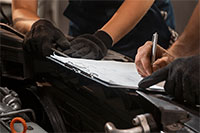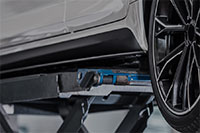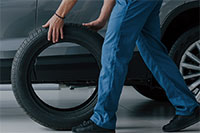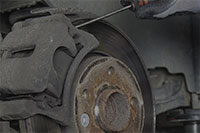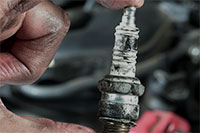When to change winter tires?
How to check tire thread?
This and more in our Pro Tips for Tire Maintenance: What Every Driver Needs to Know
This article has everything you need to know about tires and tire maintenance. At Partly Dave's Garage, we have been fixing and taking care of tires for more than 40 years, and we are happy to share some cool Pro Tips with you. You'll learn a lot about tire maintenance, including how to inspect tires for wear and damage, what to do and what not to do, and more.
Let's dive in.
- When to Change Winter Tires?
- How to Check Tire Thread?
- Why is Tire Maintenance Important?
- What Involves Regular Tire Inspection and Maintenance?
- How to Inflate Tires Properly?
- Why Do I Need Tire Rotation and Alignment?
- Signs That it's Time to Teplace my Tires
- What Should I Know about Winter, Summer, and All-season Tires?
When to change winter tires?
Winter tires are designed to provide better traction and grip on snowy and icy roads. However, once the winter season is over, it's important to replace your winter tires with all-season or summer tires to ensure optimal performance and safety. Here are some general guidelines for when to change your winter tires:
- Temperature and weather: Winter tires are made of a softer rubber compound that is designed to remain pliable in cold temperatures, which provides better traction on snow and ice. However, when temperatures rise above 7°C, the rubber can become too soft and wear out faster. Therefore, it's recommended to switch to all-season or summer tires when temperatures consistently stay above 7°C. Otherwise, keep them on until the roads are clear.
- Mileage: Winter tires typically have a shorter lifespan than all-season or summer tires, and they can wear out faster if you drive on them in warmer temperatures. Therefore, it's important to monitor the wear on your winter tires and replace them when necessary, regardless of the time of year. We got a cool tip for you on how to check tire thread below.
How to check tire thread?
Of course, you can use a tread depth gauge, but the "quarter test" is more fun.
Simply insert a 25-cent coin into the tire tread with the caribou's head facing down. If the top of the caribou's head is visible, the tire has less than 4/32" of tread depth and should be replaced soon. If the top of the caribou's head is not visible, the tire has more than 4/32" of tread depth and is considered safe to use.
Disclosure: It's important to note that the quarter test is not a substitute for regular tire inspections and should be used in conjunction with other inspection methods, such as checking for signs of wear or damage. It's also a good idea to have a professional inspect your tires regularly to ensure that they are safe and in good condition.
Why is tire maintenance important?
- Safety: Tires that are worn, underinflated, or damaged can compromise your vehicle's handling, stability, and braking performance, increasing the risk of an accident. Proper tire maintenance helps ensure that your vehicle is safe to drive.
- Improved fuel economy: Tires that are properly inflated and aligned can improve your vehicle's fuel efficiency, reducing your fuel costs and environmental impact.
- Extended tire life: Regular tire maintenance, such as rotating and balancing your tires, can help extend the life of your tires, reducing the need for expensive replacements.
- Cost savings: Proper tire maintenance can help you save money by avoiding costly repairs and premature tire replacements. It can also help you avoid fines for driving with unsafe or illegal tires.
- Improved handling: Tires that are properly inflated, aligned, and balanced can improve your vehicle's handling, making it easier to control and more comfortable to drive.
Overall, tire maintenance is essential for ensuring the safety, performance, and longevity of your vehicle's tires. By following the manufacturer's recommended maintenance schedule and regularly checking your tires for wear, damage, and proper inflation, you can help keep your vehicle running smoothly and safely.
What involves regular tire inspection and maintenance?
Regular tire inspection involves visually inspecting your tires to check for signs of wear, damage, and proper inflation. Here are some things to look for during a tire inspection:
- Tread wear: We've already covered this in our "How to check tire thread?" section.
- Tire damage: Inspect each tire for cuts, punctures, bulges, or other signs of damage. If you notice any damage, have the tire inspected by a professional.
- Proper inflation (link): Check the tire pressure using a tire pressure gauge and ensure that it matches the manufacturer's recommended pressure, which can usually be found on a sticker inside the driver's door or in the owner's manual.
- Uneven wear: Inspect the tires for signs of uneven wear, such as cupping, feathering, or wear on one side of the tire. This can indicate that the tires need to be rotated or that the vehicle's alignment needs to be adjusted.
- Age: Check the age of the tires by looking for the DOT code on the sidewall. Tires should be replaced after 6-10 years, even if they have plenty of tread left.
- Tire rotation: Rotate your tires: Rotating your tires can help even out tire wear, which can extend their life span and improve your vehicle's handling.
- Tire alignment: Proper wheel alignment ensures that your tires wear evenly, improving their performance and longevity.
- Avoid overloading your vehicle: Overloading your vehicle can cause your tires to wear out faster, leading to problems on the road. Always follow the manufacturer's recommended weight limits for your vehicle.
- Drive carefully: Avoid sudden stops and starts, sharp turns, and driving over potholes, curbs, or other obstacles. These actions can damage your tires and reduce their lifespan.
- Repair punctured tires promptly: If you notice a puncture in your tire, have it inspected and repaired by a professional as soon as possible. A punctured tire can cause problems while driving and increase the risk of accidents.
How to inflate tires properly?
Proper tire inflation is when a tire is filled with the correct amount of air pressure recommended by the vehicle manufacturer. This information can usually be found on a sticker inside the driver's door or in the owner's manual. It is important to follow the recommended tire pressure because both underinflated and overinflated tires can cause problems.
Underinflated tires can cause the tire to wear faster on the outside edges, negatively affect fuel efficiency, and increase the risk of a blowout or flat tire.
In contrast, overinflated tires can cause the tire to wear faster in the center, reduce the vehicle's handling and stability, and increase the risk of a blowout or damage to the tire or suspension system.
To check tire pressure, use a tire pressure gauge and insert it into the valve stem of the tire. The gauge will display the tire pressure in pounds per square inch (PSI). If the tire pressure is too low, add air until it reaches the recommended pressure. If the tire pressure is too high, let some air out until it reaches the recommended pressure.
It is recommended to check tire pressure at least once a month and before long road trips, as changes in temperature can affect tire pressure. Proper tire inflation can improve vehicle handling, fuel efficiency, and tire life, while reducing the risk of a tire-related accident.
Why do I need tire rotation and alignment?
Tire rotation and alignment are important for several reasons:
- Extended tire life: Regular tire rotation and alignment can help extend the life of your tires by ensuring that they wear evenly. Tires that are not rotated regularly can develop uneven wear patterns, which can reduce their life span and require premature replacements.
- Improved handling: Proper tire alignment ensures that all four wheels are pointed in the same direction, which improves vehicle handling and stability. Misaligned tires can cause the vehicle to pull to one side, make it more difficult to steer, and reduce the vehicle's stability on the road.
- Improved fuel efficiency: Proper tire alignment and rotation can improve your vehicle's fuel efficiency by reducing rolling resistance and drag, which can result in less fuel consumption.
- Cost savings: Regular tire rotation and alignment can help you save money by reducing the need for premature tire replacements and costly repairs to the suspension system.
- Safety: Proper tire alignment and rotation can improve your vehicle's safety by ensuring that it handles well and is less likely to experience tire-related problems while driving.
Overall, tire rotation and alignment are essential for maintaining the performance and longevity of your tires, as well as ensuring your vehicle's safety and stability on the road. It is recommended to have your tires rotated every 8,000 to 12,000 km and your alignment checked once a year or after hitting a pothole or curb.
Signs that it's time to replace my tires
Here are some signs that it's time to replace your tires:
- Low tread depth: Tires with worn-out treads are less effective in providing traction on wet or slippery roads, increasing the risk of accidents.
- Cracks or bulges: Cracks on the sidewall or bulges on the tire indicate internal damage or weakening of the tire's structure, which can cause blowouts and punctures, and can also increase the risk of accidents.
- Vibration: If you experience vibration or shaking while driving, it may be a sign of an out-of-balance tire or a problem with the tire's internal structure.
- Uneven wear: Uneven wear patterns on the tires can indicate that the tires are misaligned, underinflated, or damaged, and can also reduce the lifespan of the tire.
- Age: Tires can age even if they have plenty of tread left. Most tire manufacturers recommend replacing tires after 6-10 years, regardless of their wear, to avoid problems with the tire's internal structure.
- Punctures or damage: Punctures or damage that cannot be repaired with a patch kit or are located on the sidewall of the tire may require the tire to be replaced.
It is important to check your tires regularly for signs of wear, damage, and proper inflation, and to replace them when necessary to ensure your safety and the performance of your vehicle. If you notice any of these signs, it is recommended to have your tires inspected by a professional to determine if they need to be replaced.
What should I know about winter, summer, and all-season tires?
Winter, summer, and all-season tires are designed for different driving conditions and temperatures. Here's what you should know about each type of tire:
- Winter Tires: Winter tires are designed for driving in snowy and icy conditions. They are made with a softer rubber compound that remains pliable in cold temperatures, which provides better traction and grip on snow and ice. They also have deeper tread patterns and additional siping (tiny slits in the tread) that help to channel snow and water away from the tire's surface.
- Summer Tires: Summer tires are designed for driving in warm and dry conditions. They are made with a harder rubber compound that provides better handling and performance in hot temperatures. They also have shallower tread patterns and fewer sipes, which provide better grip on dry roads but less traction on wet or slippery surfaces.
- All-Season Tires: All-season tires are designed to provide good performance in a variety of weather conditions, including wet and dry roads, light snow, and icy conditions. They are made with a rubber compound that is softer than summer tires but harder than winter tires, which provides a balance of traction and grip in different temperatures. They also have tread patterns that are designed to provide good handling on a variety of surfaces.
We hope you find this article useful. If you live in Vernon and surrounding areas, you're always welcome to visit our shop for any tire maintenance or repair. We'll be happy to meet you!



